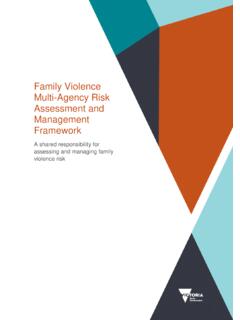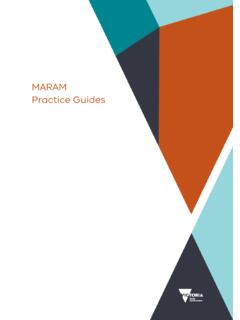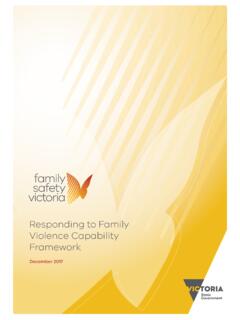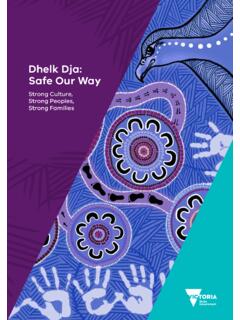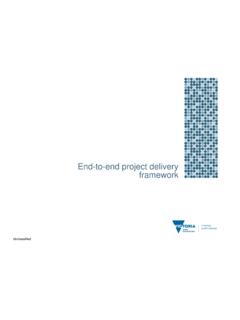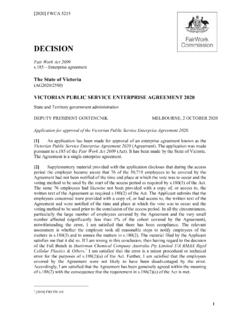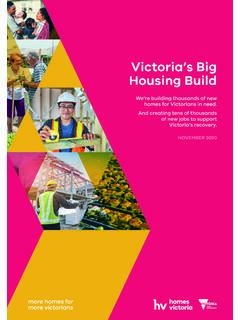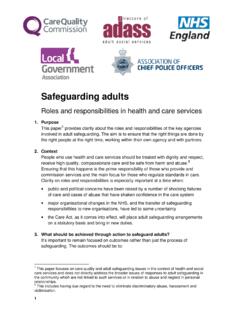Transcription of RESPONSIBILITY 2: IDENTIFICATION OF FAMILY VIOLENCE RISK
1 PRACTICE GUIDESRESPONSIBILITY 2: IDENTIFICATION OF FAMILY VIOLENCE RISK 89 NOTE: guidance and learning objectives for working with perpetrators is in development and will be available late 2020. Finalised guidance will emphasise that only key/selected professionals and services will be trained/required to provide a service response to perpetrators related to their use of learning objective for this RESPONSIBILITY 2 will include:Ensure staff understand when it might be safe to ask questions of clients who may be a perpetrator, to assist with of FAMILY VIOLENCE Overview Structured Professional Judgement in IDENTIFICATION and Screening IDENTIFICATION of and Screening for FAMILY VIOLENCE Using Prompting Questions with an Adult to Support Screening When to Use the Screening and IDENTIFICATION Tool Why Someone Might not Disclose FAMILY VIOLENCE , Even if Asked IDENTIFICATION and Screening for Children and Young People guidance on using the Screening and IDENTIFICATION Tool If it Seems FAMILY VIOLENCE is NOT Occurring If FAMILY VIOLENCE Is Occurring If FAMILY VIOLENCE is Occurring and an Immediate Response is Required What s Next?
2 101 Appendix 1: Observable signs of trauma that may indicate FAMILY VIOLENCE 102 Appendix 2: guidance on using the Screening and IDENTIFICATION Tool 106 Appendix 3: Screening and IDENTIFICATION Tool 112 Appendix 4: Response options following IDENTIFICATION and screening of FAMILY VIOLENCE risk and Basic Safety Plan 118 RESPONSIBILITY 290 MARAM PRACTICE GUIDES 91 RESPONSIBILITY 2: IDENTIFICATION OF FAMILY VIOLENCE RISK 91 IDENTIFICATION OF FAMILY VIOLENCE RISK2 .1 OVERVIEWThis chapter should be used when FAMILY VIOLENCE is suspected but not yet guidance will enable you to identify if FAMILY VIOLENCE is present and undertake screening for an adult, child or young person to assist you to decide if further action and/or assessment is required. Specific guidance on identifying VIOLENCE and use of screening tools with children and young people is outlined in Section of this professionals who have received training to engage with perpetrators about their use of VIOLENCE should do so.
3 It can increase risk to a victim survivor to engage with a perpetrator when not done CAPABILITIESAll professionals should have knowledge of RESPONSIBILITY 2, which includes: ..Awareness of the evidence-based FAMILY VIOLENCE risk factors and explanations, outlined in the Foundation Knowledge Guide ..Being familiar with the questions to identify FAMILY VIOLENCE , observable signs and indicators, using the Screening and IDENTIFICATION Tool and how-to-ask IDENTIFICATION questions ..Using information gathered through engagement with service users and other providers via information sharing to identify signs and indicators of FAMILY VIOLENCE (for adults, children and young people) and potentially identifying victim survivors. Information sharing laws and practice is further described in RESPONSIBILITY which refers to a perpetrator in this guide is relevant if an adolescent is using FAMILY VIOLENCE for the purposes of risk assessment with a victim survivor about their experience and the impact of VIOLENCE .
4 Risk assessment and management for adolescents should always consider their age, developmental stage and individual circumstances, and include therapeutic responses, as MARAM PRACTICE GUIDES2 . Who should use the Screening and IDENTIFICATION Tool?Appendix 2 contains the Screening and IDENTIFICATION Tool within a table of practice guidance . The Screening and IDENTIFICATION Tool as a standalone template is in Appendix professionals should use the Screening and IDENTIFICATION Tool, either applied routinely when this is a part of your professional role or service, or only when indicators of FAMILY VIOLENCE are is not an activity that occurs only once by a single professional or within a service. In service settings where a person has multiple contacts, it is necessary to screen over time and at each contact to ensure any changes in the relationship or use of VIOLENCE is organisations and workforces will undertake routine screening, asking every person accessing their service questions to screen for FAMILY VIOLENCE (such as in perinatal settings or Youth Justice).
5 Other workforces will only use the Screening and IDENTIFICATION Tool when they have identified indicators or signs of FAMILY VIOLENCE risk through their regular service and are seeking to confirm the presence of FAMILY (including through use of the Screening and IDENTIFICATION Tool) will support professionals to form their professional judgement about how to STRUCTURED PROFESSIONAL JUDGEMENT IN IDENTIFICATION AND SCREENINGR eflect on the model of Structured Professional Judgement outlined in Section of the Foundation Knowledge and screening is the first opportunity to ask a victim survivor about their self-assessment of their risk, fear and safety, as well as some initial questions about FAMILY VIOLENCE risk factors. These can by further informed by risk assessment and information sharing, described in later RESPONSIBILITY 1: Model of Structured Professional JudgementPROFESSIONAL JUDGMENT INTERSECTIONAL ANALYSISINFORMATION SHARINGEVIDENCE-BASED RISK FACTORSVICTIM SURVIVOR SELF-ASSESSMENTI dentification and screening is the first step in understanding if FAMILY VIOLENCE risk factors are present, and is informed by a person s assessment of their own level of FAMILY VIOLENCE risk (self-assessment).
6 Observing signs and indicators of risk and asking screening questions about FAMILY VIOLENCE support these two elements of Structured Professional IDENTIFICATION OF AND SCREENING FOR FAMILY VIOLENCEI dentifying and screening for FAMILY VIOLENCE means identifying that FAMILY VIOLENCE risk factors are present. This can be done through observation of signs of trauma that may indicate FAMILY VIOLENCE is occurring, and/or confirming this by undertaking involves asking questions defined in a tool (provided in Appendix 3) to enable a person to disclose whether they are experiencing FAMILY VIOLENCE . The questions are designed to identify information about evidence-based FAMILY VIOLENCE risk factors. The Screening and IDENTIFICATION Tool includes some of the high-risk factors associated with an increased likelihood of a person being killed or almost killed. All of the questions in the Screening and IDENTIFICATION Tool should be asked, when possible.
7 93 RESPONSIBILITY 2: IDENTIFICATION OF FAMILY VIOLENCE RISK 93 Before beginning, you should discuss the purpose of the Screening and IDENTIFICATION Tool (or risk assessment) with the person. You should acknowledge that some of the questions may be confronting and difficult to answer but that they are important for assessing risk and identifying appropriate What are FAMILY VIOLENCE risk factors?The FAMILY VIOLENCE risk factors are outlined with a short description in the Foundation Knowledge Guide at Section 8. FAMILY VIOLENCE risk factors are evidence-based factors that are used to: ..Identify if a person is experiencing FAMILY VIOLENCE ..Identify the level of risk, and ..Identify the likelihood of VIOLENCE 3 describes how to assess for risk factors, including determining the level or seriousness of Observable signs of trauma that may indicate that FAMILY VIOLENCE is occurringFamily VIOLENCE risk factors may be identified through observing signs or indicators related to a person s physical or emotional presentation, behaviour or circumstances.
8 These signs are presentations of possible trauma, which may indicate FAMILY VIOLENCE is occurring and can be expressed differently across a person s lifespan, from infancy, childhood and adolescence1, through to adulthood and old 1, Tables 1 5, contain a non-exhaustive list of signs of trauma which may indicate that FAMILY VIOLENCE is occurring for adults and For young people over the age of 18 signs and indicators for adults signs of trauma do not by themselves determine that FAMILY VIOLENCE is occurring, they are indicators only at this stage. These signs may also indicate that another form of trauma has occurred. If you suspect someone is experiencing FAMILY VIOLENCE , it is important to ask the person screening questions about FAMILY and children experiencing FAMILY VIOLENCE may also not exhibit any of these signs and indicators. If you don t observe any signs or indicators but think that something is not quite right , you should use prompting questions or the Screening and IDENTIFICATION Tool to explore whether FAMILY VIOLENCE might be Signs and indicators relating to age for children and young people2 Signs of trauma in a child or young person may indicate FAMILY VIOLENCE or another form of trauma.
9 Signs may be observed through the presentation, behaviour or circumstances of a child or young person. Some signs may relate to trauma from specific forms of FAMILY VIOLENCE , including sexual abuse (indicated by) or emotional abuse (indicated by *).Some signs may indicate a child s experience of trauma or other circumstances outside of the FAMILY or home environment. Consider the wellbeing and safety of a child within and outside of the FAMILY context when observing these s behaviours may be driven by a range of underlying factors, including disability, developmental issues, and non- FAMILY VIOLENCE related trauma and you will need to consider how these factors may be affecting or reinforcing each other. Significant changes in behaviour can indicate the presence of FAMILY VIOLENCE and/or increased For further information of indicators of FAMILY VIOLENCE in children and young people, see the practice resource by the Department of Health and Human Services, Assessing children and young people experiencing FAMILY VIOLENCE : a practice guide for FAMILY VIOLENCE MARAM PRACTICE GUIDESO bservable general signs of trauma for a child or young person of any age are listed in Appendix 1, Table 2.
10 Signs can also vary considerably according to the age and stage of a child or young person s development, and are listed in Appendix 1, Tables 3 and the presence of FAMILY VIOLENCE may be observed from a child s circumstances and may relate to neglect due to the experience of FAMILY VIOLENCE . Some signs or indicators of neglect are listed in Appendix 1, Table on whether to assess children and young people directly, or through asking questions of a parent/carer who is not using VIOLENCE , is outlined at Section USING PROMPTING QUESTIONS WITH AN ADULT TO SUPPORT SCREENINGYou can use broad, prompting questions that lead into screening questions to begin the conversation. You can use your judgement on how to use these example questions or other prompting questions appropriate to the individual or their can begin by asking open-ended, rapport-building questions about their wellbeing, for example.
